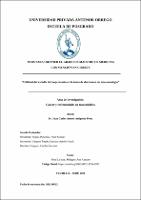Utilidad del estudio intraoperatorio en la toma de decisiones en uro-oncología

View/
Download
(application/pdf: 566.4Kb)
(application/pdf: 566.4Kb)
Date
2021Author(s)
Astigueta Pérez, Juan Carlos Arturo
Metadata
Show full item recordAbstract
Determinar la utilidad del estudio intraoperatorio (EIO) en pacientes con
neoplasias uro-oncológicas.
Materiales y métodos: estudio analítico, observacional, transversal, de prueba
diagnóstica. Se evaluó los resultados anatomo-patológicos de pacientes tratados en el
servicio de urología del Instituto Regional de Enfermedades Neoplásicas Norte (IREN
Norte), en el periodo comprendido entre los años 2010 y 2019, en el que se comparó el
resultado del EIO con el obtenido en el estudio histológico (EH) procesado en parafina
(prueba de oro).
Resultados: Se incluyeron 66 EIO con sus respectivos estudios histológicos, 16 (24%)
pacientes fueron de sexo femenino y 50 (76%) masculino. La edad promedio fue 52.1,
con un rango entre 17 y 84 años.
Del total de EIO, fueron positivos para neoplasia maligna 37 (56.1%), negativos 28
(42.4%) y 1 (1.5%) no pudo definirse. En el EH se corroboró el diagnóstico en 62 casos
(95.4%) y se encontró discrepancias en 3 (4.6%); la biopsia no definida en el EIO fue
negativa para neoplasia maligna.
La sensibilidad, especificidad, valor predictivo positivo, valor predictivo negativo y
exactitud diagnóstica del EIO fueron 94.7, 96.3, 97.3, 92.9 y 95.4% respectivamente; así
mismo, la razón de verosimilitud positiva y negativa fueron 25.6 y 0.05.
Conclusión: el EIO en uro-oncología es útil y altamente confiable en la toma de
decisiones durante el acto quirúrgico. To determine the usefulness of the intraoperative study (IS) in patients with
uro-oncological neoplasms.
Materials and methods: analytical, observational, cross-sectional study of a diagnostic
test, evaluating the anatomo-pathological results of patients treated in the urology service
of the Instituto Regional de Enfermedades Neoplásicas Norte (IREN Norte), in the period
between 2010 and 2019, in which the result of the IO was compared with that obtained
in the histological study (EH) processed in paraffin (gold test).
Results: 66 IS with their respective histological studies were included, 16 (24%) patients
were female and 50 (76%) male. The average age was 52.1, with a range between 17 and
84 years.
Of the total IS, 37 (56.1%) were positive for malignant neoplasia, 28 (42.4%) negative
and 1 (1.5%) could not be defined. In HE, the diagnosis was corroborated in 62 cases
(95.4%) and discrepancies were found in 3 (4.6%); the undefined biopsy in the IS was
negative for malignancy.
The sensitivity, specificity, positive predictive value, negative predictive value and
diagnostic accuracy of the IS were 94.7, 96.3, 97.3, 92.9 and 95.4% respectively;
likewise, the positive and negative likelihood ratios were 25.6 and 0.05.
Conclusion: the IS in uro-oncology is useful and highly reliable in decision-making
during surgery.

